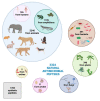Bioactive Antimicrobial Peptides: A New Weapon to Counteract Zoonosis
- PMID: 36014009
- PMCID: PMC9414035
- DOI: 10.3390/microorganisms10081591
Bioactive Antimicrobial Peptides: A New Weapon to Counteract Zoonosis
Abstract
Zoonoses have recently become the center of attention of the general population and scientific community. Notably, more than 30 new human pathogens have been identified in the last 30 years, 75% of which can be classified as zoonosis. The complete eradication of such types of infections is far out of reach, considering the limited understanding of animal determinants in zoonoses and their causes of emergence. Therefore, efforts must be doubled in examining the spread, persistence, and pathogenicity of zoonosis and studying possible clinical interventions and antimicrobial drug development. The search for antimicrobial bioactive compounds has assumed great emphasis, considering the emergence of multi-drug-resistant microorganisms. Among the biomolecules of emerging scientific interest are antimicrobial peptides (AMPs), potent biomolecules that can potentially act as important weapons against infectious diseases. Moreover, synthetic AMPs are easily tailored (bioinformatically) to target specific features of the pathogens to hijack, inducing no or very low resistance. Although very promising, previous studies on SAMPs' efficacy are still at their early stages. Indeed, further studies and better characterization on their mechanism of action with in vitro and in vivo assays are needed so as to proceed to their clinical application on human beings.
Keywords: antimicrobial peptides; antimicrobial treatment; infection; zoonosis.
Conflict of interest statement
The authors declare no conflict of interest.
Figures



Similar articles
-
Important Roles and Potential Uses of Natural and Synthetic Antimicrobial Peptides (AMPs) in Oral Diseases: Cavity, Periodontal Disease, and Thrush.J Funct Biomater. 2022 Oct 3;13(4):175. doi: 10.3390/jfb13040175. J Funct Biomater. 2022. PMID: 36278644 Free PMC article. Review.
-
Synthetic antimicrobial peptides: Characteristics, design, and potential as alternative molecules to overcome microbial resistance.Life Sci. 2021 Aug 1;278:119647. doi: 10.1016/j.lfs.2021.119647. Epub 2021 May 24. Life Sci. 2021. PMID: 34043990 Review.
-
Antimicrobial peptides (AMPs): A promising class of antimicrobial compounds.J Appl Microbiol. 2022 Mar;132(3):1573-1596. doi: 10.1111/jam.15314. Epub 2021 Oct 13. J Appl Microbiol. 2022. PMID: 34606679 Review.
-
In Vitro Evaluation of Antimicrobial Peptides from the Black Soldier Fly (Hermetia Illucens) against a Selection of Human Pathogens.Microbiol Spectr. 2022 Feb 23;10(1):e0166421. doi: 10.1128/spectrum.01664-21. Epub 2022 Jan 5. Microbiol Spectr. 2022. PMID: 34985302 Free PMC article.
-
The characteristics and roles of antimicrobial peptides as potential treatment for antibiotic-resistant pathogens: a review.PeerJ. 2021 Dec 14;9:e12193. doi: 10.7717/peerj.12193. eCollection 2021. PeerJ. 2021. PMID: 35003909 Free PMC article.
Cited by
-
Antibacterial Effect of Sesame Protein-Derived Peptides against Escherichia coli and Staphylococcus aureus: In Silico and In Vitro Analysis.Nutrients. 2024 Jan 4;16(1):175. doi: 10.3390/nu16010175. Nutrients. 2024. PMID: 38202004 Free PMC article.
References
-
- World Health Organization WHO-Convened Global Study of Origins of SARS-CoV-2: China Part. [(accessed on 9 June 2022)]. Available online: https://www.who.int/publications-detail-redirect/who-convened-global-stu....
-
- World Health Organization Zoonoses. [(accessed on 9 June 2022)]. Available online: https://www.who.int/news-room/fact-sheets/detail/zoonoses.
-
- CDC Centers for Disease Control and Prevention Zoonotic Diseases|One Health|CDC. [(accessed on 9 June 2022)]; Available online: https://www.cdc.gov/onehealth/basics/zoonotic-diseases.html.
-
- World Health Organization Eastern Mediterranean Regional Office Zoonotic Disease: Emerging Public Health Threats in the Region. [(accessed on 9 June 2022)]. Available online: http://www.emro.who.int/about-who/rc61/zoonotic-diseases.html.
Publication types
Grants and funding
- RC 47/20/Ministry of Health, Rome - Italy / Institute for Maternal and Child Health IRCCS Burlo Garofolo
- QUCG-CAS-22/23-499 Collaborative Grant/Qatar University
- 88881.507105 /2020-01/CAPES (Coordination for the Improvement of Higher Education Personnel)
- 313581/2020-7/CNPq (National Council for Scientific and Technological Development)
LinkOut - more resources
Full Text Sources

